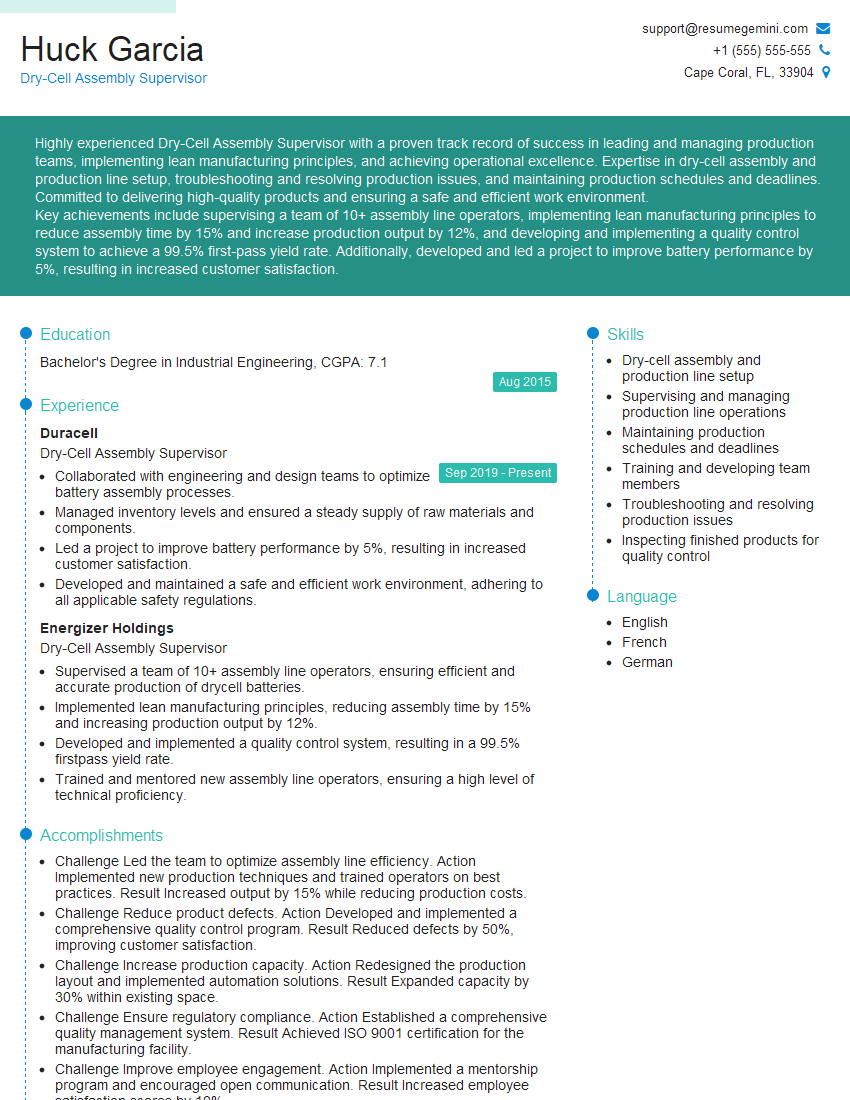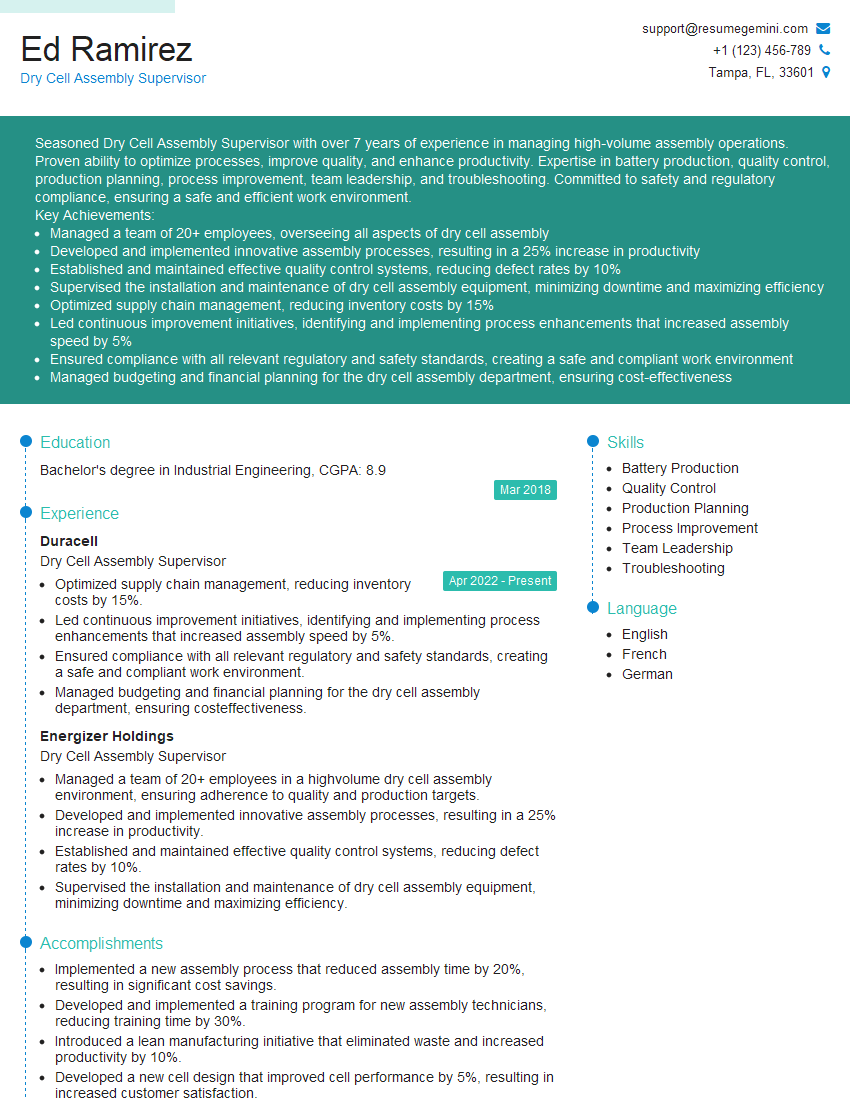Ever felt underprepared for that crucial job interview? Or perhaps you’ve landed the interview but struggled to articulate your skills and experiences effectively? Fear not! We’ve got you covered. In this blog post, we’re diving deep into the Dry-Cell Assembly Supervisor interview questions that you’re most likely to encounter. But that’s not all. We’ll also provide expert insights into the key responsibilities of a Dry-Cell Assembly Supervisor so you can tailor your answers to impress potential employers.
Acing the interview is crucial, but landing one requires a compelling resume that gets you noticed. Crafting a professional document that highlights your skills and experience is the first step toward interview success. ResumeGemini can help you build a standout resume that gets you called in for that dream job.
Essential Interview Questions For Dry-Cell Assembly Supervisor
1. What are the key responsibilities of a Dry-Cell Assembly Supervisor?
As a Dry-Cell Assembly Supervisor, my primary responsibilities would encompass:
- Supervising and coordinating the production of dry-cell batteries according to established quality standards and production schedules.
- Managing a team of assembly line operators, ensuring their training, motivation, and adherence to safety protocols.
2. Describe the steps involved in the assembly of a dry-cell battery.
The assembly of a dry-cell battery involves several key steps:
Mixing and preparation of the electrolyte
- Preparing the electrolyte paste by combining chemicals and solvents.
- Ensuring the proper mixing and consistency of the electrolyte.
Manufacturing the electrodes
- Creating the positive electrode (cathode) using manganese dioxide and other materials.
- Producing the negative electrode (anode) using zinc powder and a binder.
Cell assembly
- Inserting electrodes and separators into the battery case.
- Pouring the electrolyte paste into the cell.
- Sealing the cell and completing the assembly process.
Testing and packaging
- Conducting electrical tests to ensure battery performance.
- Packaging the batteries for storage and distribution.
3. What are the common defects encountered during dry-cell battery assembly and how can they be minimized?
During dry-cell battery assembly, various defects can occur. Some common defects and their potential solutions include:
- Leakage: Ensure proper sealing of cells, maintain appropriate electrolyte levels, and inspect batteries for any punctures or damage.
- Short circuit: Prevent contact between positive and negative electrodes by using separators and ensuring proper electrode alignment.
- Insufficient capacity: Optimize electrolyte composition and electrode materials, monitor production parameters, and conduct quality checks to ensure battery performance.
- Low voltage: Ensure proper cell assembly, check electrode quality and purity, and optimize electrolyte concentration.
- Terminal corrosion: Use corrosion-resistant materials for terminals, apply protective coatings, and maintain proper storage conditions.
4. How do you monitor and maintain the quality of batteries during assembly?
Ensuring battery quality during assembly involves implementing several key measures:
- Establishing quality control standards: Define specifications for materials, processes, and finished products.
- Conducting regular inspections: Monitor production processes, inspect materials and components, and perform quality checks at various stages of assembly.
- Utilizing testing equipment: Employ specialized equipment to evaluate battery performance, including voltage, capacity, and internal resistance.
- Data analysis and corrective actions: Collect and analyze quality data, identify trends, and implement corrective actions to improve processes.
- Employee training and involvement: Provide training on quality control procedures and empower employees to contribute to continuous improvement efforts.
5. How do you handle production line stoppages and minimize their impact?
Addressing production line stoppages requires a proactive and efficient approach:
- Swift response: React promptly to stoppages to minimize downtime.
- Problem identification: Quickly identify the root cause of the stoppage through observation, communication with operators, and data analysis.
- Corrective action: Implement appropriate solutions to resolve the issue, such as equipment repairs, material adjustments, or process modifications.
- Preventive measures: Analyze previous stoppages to identify patterns and implement preventive measures, such as predictive maintenance or process optimization.
- Communication: Keep team members and management informed about stoppages and the actions being taken.
6. Describe your approach to safety management in a dry-cell assembly environment.
Ensuring safety in a dry-cell assembly environment involves adhering to comprehensive measures:
- Hazard identification and assessment: Regularly identify and assess potential hazards associated with materials, processes, and equipment.
- Risk mitigation: Implement appropriate controls to minimize risks, such as engineering controls (e.g., ventilation systems), administrative controls (e.g., safe work procedures), and personal protective equipment (PPE).
- Employee training: Provide comprehensive safety training to employees, covering topics such as hazard awareness, emergency procedures, and PPE usage.
- Emergency preparedness: Establish clear emergency protocols, conduct drills, and ensure access to appropriate safety equipment.
- Compliance with regulations: Adhere to all applicable safety regulations and industry standards.
7. How do you optimize production efficiency while maintaining quality standards?
Optimizing production efficiency and maintaining quality standards require a balanced approach:
- Process improvement: Continuously review and optimize production processes to minimize waste and increase efficiency.
- Automation and technology: Utilize automation and advanced technologies to enhance efficiency without compromising quality.
- Employee empowerment: Engage employees in improvement initiatives and encourage their suggestions for process enhancements.
- Quality control integration: Incorporate quality control measures throughout the production process to ensure consistent quality.
- Data analysis: Monitor production data, identify bottlenecks, and implement targeted improvements.
8. How do you motivate and lead a team of assembly line operators?
Effective leadership and motivation are crucial for a successful team:
- Clear communication: Establish clear expectations, provide regular feedback, and maintain open communication channels.
- Recognition and appreciation: Recognize and appreciate employee contributions, achievements, and efforts.
- Empowerment and delegation: Empower employees to take ownership of their tasks and decision-making.
- Collaboration and teamwork: Foster a collaborative and supportive work environment that encourages teamwork and knowledge sharing.
- Continuous improvement: Engage employees in continuous improvement initiatives, seeking their input and suggestions.
9. What are your strategies for reducing waste and improving sustainability in battery production?
Promoting sustainability in battery production involves implementing various strategies:
- Material optimization: Reduce waste by optimizing material usage, exploring alternative materials, and implementing recycling programs.
- Energy efficiency: Implement energy-efficient production processes, utilize renewable energy sources, and reduce energy consumption.
- Waste management: Establish a comprehensive waste management system to minimize environmental impact.
- Sustainable packaging: Use eco-friendly packaging materials, reduce packaging waste, and explore reusable or biodegradable options.
- Collaboration with suppliers: Partner with suppliers who share sustainability goals and prioritize environmentally responsible practices.
10. Describe your experience in managing production schedules and ensuring on-time delivery.
Effective production scheduling and on-time delivery require meticulous planning and execution:
- Production planning: Collaborate with cross-functional teams to develop realistic production schedules that align with customer demand.
- Resource allocation: Optimize resource allocation, including manpower, equipment, and materials, to meet production targets.
- Monitoring and adjustment: Continuously monitor production progress and make adjustments as needed to ensure on-time delivery.
- Communication and coordination: Maintain open communication with production teams, suppliers, and customers to address any potential issues.
- Contingency planning: Develop contingency plans to mitigate potential disruptions and ensure timely delivery.
Interviewers often ask about specific skills and experiences. With ResumeGemini‘s customizable templates, you can tailor your resume to showcase the skills most relevant to the position, making a powerful first impression. Also check out Resume Template specially tailored for Dry-Cell Assembly Supervisor.
Career Expert Tips:
- Ace those interviews! Prepare effectively by reviewing the Top 50 Most Common Interview Questions on ResumeGemini.
- Navigate your job search with confidence! Explore a wide range of Career Tips on ResumeGemini. Learn about common challenges and recommendations to overcome them.
- Craft the perfect resume! Master the Art of Resume Writing with ResumeGemini’s guide. Showcase your unique qualifications and achievements effectively.
- Great Savings With New Year Deals and Discounts! In 2025, boost your job search and build your dream resume with ResumeGemini’s ATS optimized templates.
Researching the company and tailoring your answers is essential. Once you have a clear understanding of the Dry-Cell Assembly Supervisor‘s requirements, you can use ResumeGemini to adjust your resume to perfectly match the job description.
Key Job Responsibilities
The Dry-Cell Assembly Supervisor is responsible for overseeing, planning, scheduling, and directing all aspects of dry-cell assembly operations within a manufacturing facility. The key responsibilities of this role include:
1. Production Management
Supervising and directing production activities to ensure efficient and timely assembly of dry cells.
- Developing and implementing production plans that optimize output and meet customer requirements.
- Scheduling and coordinating production activities to maximize efficiency, minimize downtime, and meet deadlines.
2. Quality Control
Establishing and maintaining quality standards for dry-cell assembly processes.
- Developing and implementing quality control procedures to monitor and assess product quality at various stages of the assembly process.
- Identifying and addressing potential quality issues, implementing corrective actions, and ensuring compliance with quality standards.
3. Team Management
Leading, motivating, and developing a team of production operators.
- Recruiting, training, and onboarding new employees.
- Providing ongoing training and support to improve employee skills and productivity.
4. Equipment Maintenance
Maintaining and inspecting assembly equipment to ensure optimal performance.
- Conducting regular equipment inspections and preventive maintenance procedures.
- Identifying and troubleshooting equipment malfunctions, implementing repairs as necessary.
Interview Tips
Preparing for an interview for a Dry-Cell Assembly Supervisor position requires thorough research and practice. Here are some tips to help you ace the interview:
1. Research the company and role
Before the interview, thoroughly research the company’s background, products, and industry standing. Understand the specific responsibilities and requirements of the Dry-Cell Assembly Supervisor role.
- Visit the company’s website, LinkedIn page, and industry publications to gather information.
- Review the job description carefully and identify key qualifications and skills the interviewer will be seeking.
2. Practice your answers
Prepare answers to common interview questions, such as those related to your experience, skills, and why you are interested in the role. Use the STAR (Situation, Task, Action, Result) method to structure your responses.
- For example, if asked about a time you managed a team, describe a specific situation, the task you were responsible for, the actions you took, and the positive results achieved.
- Practice your answers out loud to gain confidence and fluency.
3. Showcase your knowledge and experience
During the interview, highlight your relevant experience, skills, and knowledge in dry-cell assembly operations.
- Quantify your accomplishments whenever possible using specific metrics and data.
- Emphasize your understanding of quality control principles, production planning, and team management.
4. Prepare questions for the interviewer
Asking thoughtful questions at the end of the interview demonstrates your engagement and interest in the role. Prepare a few questions that show you have done your research and want to learn more about the company.
- For example, you could ask about the company’s growth plans, the challenges facing the industry, or the opportunities for professional development within the organization.
- Asking questions also gives you an opportunity to assess if the company and role are the right fit for you.
5. Professionalism and follow-up
Throughout the interview, maintain a professional demeanor and dress appropriately. Be respectful of the interviewer’s time and follow up with a thank-you note within 24 hours of the interview.
- In your thank-you note, reiterate your interest in the role and highlight specific aspects of the interview that impressed you.
- Thank the interviewer for their time and consideration.
Next Step:
Now that you’re armed with interview-winning answers and a deeper understanding of the Dry-Cell Assembly Supervisor role, it’s time to take action! Does your resume accurately reflect your skills and experience for this position? If not, head over to ResumeGemini. Here, you’ll find all the tools and tips to craft a resume that gets noticed. Don’t let a weak resume hold you back from landing your dream job. Polish your resume, hit the “Build Your Resume” button, and watch your career take off! Remember, preparation is key, and ResumeGemini is your partner in interview success.

